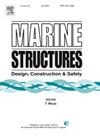双轴载荷和侧压作用下连续加筋板极限强度的简化估算方法
IF 5.1
2区 工程技术
Q1 ENGINEERING, CIVIL
引用次数: 0
摘要
提出了一种计算连续加筋板在纵向、横向联合荷载和侧向压力作用下极限强度的简化方法。为了更合理地设计船体结构,有必要开发一种具有坚实物理基础的估算方法。以前的方法是在理论上发展起来的,除了初始挠度之外,还明确考虑了诸如后屈曲和屈服行为等因素。然而,这些方法往往需要数值迭代,如牛顿-拉夫森方法,以获得载荷-挠度关系。在本研究中,推导了加筋板弹性后屈曲行为的解析解,从而消除了数值迭代的需要;这使得开发一种简单而实用的估算极限强度的方法成为可能。通过非线性有限元分析(NLFEA)对加筋板的倒塌行为进行观察和分类,通过评估与确定的倒塌模式相对应的预定位置的屈服来预测加筋板的极限强度。通过与NLFEA结果的比较,验证了该方法的准确性。本文章由计算机程序翻译,如有差异,请以英文原文为准。
Simplified ultimate strength estimation method of continuous stiffened panels under biaxial loads and lateral pressure
A simplified method is proposed for estimating the ultimate strength of continuous stiffened panels subjected to combined longitudinal and transverse loads, as well as lateral pressure. For the more rational design of ship hull structures, it is essential to develop an estimation method with a solid physical basis. Previous methods have been developed theoretically, explicitly considering factors such as post-buckling and yielding behaviors in addition to initial deflection. However, these approaches often require numerical iterations, such as the Newton-Raphson method, to obtain the load-deflection relationships. In this study, analytical solutions are derived for the elastic post-buckling behaviors of stiffened panels, eliminating the need for numerical iterations; this enables the development of a simple yet practical method for estimating the ultimate strength. By observing and classifying the collapse behavior of stiffened panels through nonlinear finite element analysis (NLFEA), the ultimate strength can be predicted by assessing yielding at predefined locations corresponding to the identified collapse modes. The accuracy of the proposed method is validated through comparisons with NLFEA results.
求助全文
通过发布文献求助,成功后即可免费获取论文全文。
去求助
来源期刊

Marine Structures
工程技术-工程:海洋
CiteScore
8.70
自引率
7.70%
发文量
157
审稿时长
6.4 months
期刊介绍:
This journal aims to provide a medium for presentation and discussion of the latest developments in research, design, fabrication and in-service experience relating to marine structures, i.e., all structures of steel, concrete, light alloy or composite construction having an interface with the sea, including ships, fixed and mobile offshore platforms, submarine and submersibles, pipelines, subsea systems for shallow and deep ocean operations and coastal structures such as piers.
 求助内容:
求助内容: 应助结果提醒方式:
应助结果提醒方式:


